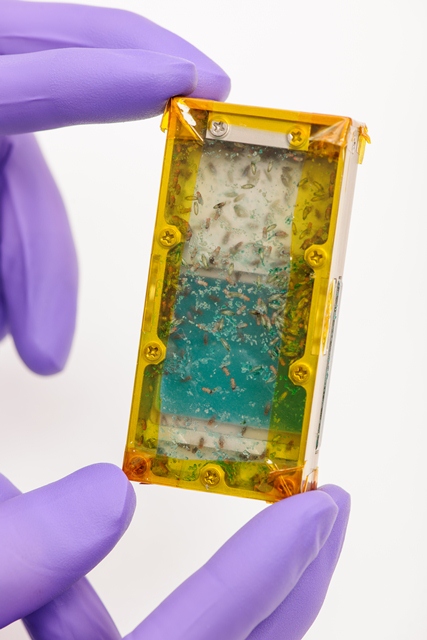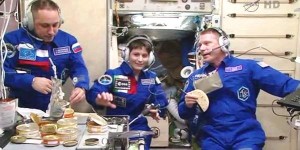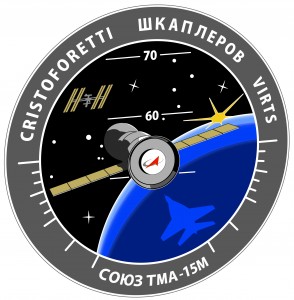I’m a plumber by profession
10/06/2015
10/06/2015
06/06/2015
 Then it means you are useless since we already know about these diseases in humans, what is your purpose?
Look, try switching on your brain, please. Scientists know about the genetic diseases of humans, but it is difficult to study the genetic transmission of a disease as it spans the lifetime of a human being, around 70-80 years. We reproduce very fast: our life spans a couple of your weeks and each female lays around 600 eggs. Get where we are going? Our genome is transmitted in real-time, “live” in front of scientists eyes, to many descendants.
From your reaction it seems as though you still do not get it, do you?
But how many are going to space?
We start with a little more than 100. It is the mechanism of genetic transmission that interests scientists, understand? And we show it to them, generation after generation.
But why on the International Space Station?
Because there is no gravity up there. And gravity could be an important part of genetic transmission. Our scientists have created a beautiful experiment!
Tell me more … how does it work?
The Fruit Lab System has three components: a small housing compartment in which we launch. A second compartment is where we live and get fed and where our larvae are extracted.
What do the astronauts do with your larvae? Do they eat them? Are you fresh food?
What??? Where do you come from? The larvae are stored in a refrigerator called MELFI where our offspring are preserved and brought back to Earth for further study.
There is a third housing compartment, where we can fly freely, assuming we are not affected by weightlessness too much. Here scientists mounted a camera to watch us 24 hours a day. A sort of Big Brother for fruit flies. A number of us live in weightlessness while others live in a small centrifuge to simulate Earth’s gravity. The larvae we produce are frozen, brought back to earth and studied.
Are you really convinced that something interesting for mankind may come out of this?
Of course, this is what we aim for and the scientists whom we are trying to help. We have been helping humans to understand how their bodies function for over a century!
If you want to educate yourself, we have a dedicated blog on this experiment:
https://www.nasa.gov/ames/research/space-biosciences/fruit-fly-lab-ffl-01-engineers-blog/#.VMDVsCzhino
And Samantha Cristoforetti talked about it in her blog entry: https://plus.google.com/+SamanthaCristoforetti/posts/PGvbX97yTee
Featuring in the cover image: The habitat for astro fruit flies created especially for studies in microgravity. Credits: NASA-Dominic Hart
Then it means you are useless since we already know about these diseases in humans, what is your purpose?
Look, try switching on your brain, please. Scientists know about the genetic diseases of humans, but it is difficult to study the genetic transmission of a disease as it spans the lifetime of a human being, around 70-80 years. We reproduce very fast: our life spans a couple of your weeks and each female lays around 600 eggs. Get where we are going? Our genome is transmitted in real-time, “live” in front of scientists eyes, to many descendants.
From your reaction it seems as though you still do not get it, do you?
But how many are going to space?
We start with a little more than 100. It is the mechanism of genetic transmission that interests scientists, understand? And we show it to them, generation after generation.
But why on the International Space Station?
Because there is no gravity up there. And gravity could be an important part of genetic transmission. Our scientists have created a beautiful experiment!
Tell me more … how does it work?
The Fruit Lab System has three components: a small housing compartment in which we launch. A second compartment is where we live and get fed and where our larvae are extracted.
What do the astronauts do with your larvae? Do they eat them? Are you fresh food?
What??? Where do you come from? The larvae are stored in a refrigerator called MELFI where our offspring are preserved and brought back to Earth for further study.
There is a third housing compartment, where we can fly freely, assuming we are not affected by weightlessness too much. Here scientists mounted a camera to watch us 24 hours a day. A sort of Big Brother for fruit flies. A number of us live in weightlessness while others live in a small centrifuge to simulate Earth’s gravity. The larvae we produce are frozen, brought back to earth and studied.
Are you really convinced that something interesting for mankind may come out of this?
Of course, this is what we aim for and the scientists whom we are trying to help. We have been helping humans to understand how their bodies function for over a century!
If you want to educate yourself, we have a dedicated blog on this experiment:
https://www.nasa.gov/ames/research/space-biosciences/fruit-fly-lab-ffl-01-engineers-blog/#.VMDVsCzhino
And Samantha Cristoforetti talked about it in her blog entry: https://plus.google.com/+SamanthaCristoforetti/posts/PGvbX97yTee
Featuring in the cover image: The habitat for astro fruit flies created especially for studies in microgravity. Credits: NASA-Dominic Hart
Stefano Sandrelli
27/01/2015
“Yes sir”, said the waiter… “This is Milliways, the Restaurant at the end of the Universe.”
The Restaurant at the End of the Universe is one of the most extraordinary ventures in the history of catering. It has been built on the fragmented remains of… it will be built on the fragmented… that is to say it will have been built by this time, and indeed has been … It is built on the fragmented remains of an eventually ruined planet which is (wioll haven be) enclosed in a vast time bubble and projected forward in time to the precise moment of the End of the Universe..
So far, things do sound a bit strange compared to restaurants on Earth. But in the meantime Zaphod, Trillian and Ford have arrived at theirtable…
A large dairy animal approached Zaphod Beeblebrox’s table… “Good evening” it lowed and sat back on heavily on its haunches “I am the main dish of the day (…) I’ve been exercising it and eating plenty of grain, so there’s a lot of good meat there.”
 What the characters in the Hitchhikers Guide of the Galaxy are experiencing in the book is not a common experience for earthlings: when we sit at our table at a restaurant the dish of the day certainly does not come to greet us!
What the characters in the Hitchhikers Guide of the Galaxy are experiencing in the book is not a common experience for earthlings: when we sit at our table at a restaurant the dish of the day certainly does not come to greet us!
It sounds impossible… but there is one thing that Douglas Adams and his talking dish got right: plenty of whole- grains and exercise is the key to staying healthy.
It is not science fiction and it is true for all Earthling’s such as Arthur Dent… and even Marvin!
Here at Outpost42 we believe that it does not take much to stay healthy, there are no complicated and obscure rules: what we need to understand is how the food we eat “talks” to our bodies.
And that is why we would like you to start this adventure with us.
So, what are you waiting for, get on board…or better yet get to the dining table! The Futura mission has just started and every week, together we will try to understand how to put the right fuel into our bodies to make them work at their best levels… just like the Soyuz!
Samantha Cristoforetti
24/11/2014
Anton Shkaplerov and Terry Virts: do you recognize them? They are Samantha Cristoforetti’ s fellow mission members. They were assigned the Soyuz TMA-15M mission that, in late November, will take them to the International Space Station.
Imagine them designing the mission patch for the Soyuz that will take them to space. What do you think they will desing? Here’s a clue: Samantha, Terry and Anton are not just astronauts, but also pilots. Do you have an idea? Here’s another hint: they all wanted to focus on the concept of balance.
 At this point, if you are a fan of flight simulators, you might have guessed what it might look like. Here is a third clue. imagine three tennis players inspired by their tennis racket.. Or three cyclists had taken the handlebar as a suggestion. Is it clear? No? Okay, will tell you: do you know the instrument on an aircraft’s dashboard showing the vehicle’s attitude during the flight? Yes, the one that tells the pilot the aircraft is pointing in the right direction? It is one of the most important tools for a pilot: the attitude indicator or artificial horizon.
At this point, if you are a fan of flight simulators, you might have guessed what it might look like. Here is a third clue. imagine three tennis players inspired by their tennis racket.. Or three cyclists had taken the handlebar as a suggestion. Is it clear? No? Okay, will tell you: do you know the instrument on an aircraft’s dashboard showing the vehicle’s attitude during the flight? Yes, the one that tells the pilot the aircraft is pointing in the right direction? It is one of the most important tools for a pilot: the attitude indicator or artificial horizon.
Samantha, Terry and Anton were inspired by just that. As if they are telling us: we go to space, but we need balance and technology.
Thanks to graphic design of Riccardo Rossi, the horizontal reference lines in the indicator are represented by the Soyuz itself and its solar panels, while the angular scales represent the angles of pitch and roll. The Soyuz corresponds to a roll angle of 15° and 15 is the serial number of this Soyuz TMA and a pitch angle of 51° which corresponds to the inclination of the orbit with respect to the equator.
But that’s not all. As in a medieval bestiary, there are countless other references and symbols. For example, the Sunrise depicts awareness and renewal, while the three stars more evident near the constellations of Auriga and Cassiopeia, represent the spaceflight dreams of the astronauts. As if their dreams had become stars.
Finally, the total number of stars corresponds to the last two digits of the launch year (2014), and – if we include the Sun – the last two digits of the year during which they will return (2015).
Finally, one last significant note. Look at the shadow of the Soyuz. It is not in the form of the Russian capsule but it has the shape of an airplane. In particular, it combines elements of a Russian MiG-29, a US F-16 and an Italian AMX, to underline the inextricable link between aviation and spaceflight.
Stefano Sandrelli
15/10/2014
At Earth’s surface, escape velocity (the speed needed to leave our planet) is about 11.2 km/s, more than 40 thousand km/h. Many science fiction writers came up with systems could transport personnel and equipment directly from Earth into space without rocket propulsion. Well-known writers such as Arthur C. Clarke and Frank Shätzing have written about the space elevator – whose complex implementation has been an object of study for space agencies. Once built, the economic return of a space elevator would be obvious: reduced transportation costs and the possibility of launching satellites and shuttles simply using centrifugal force. At the moment, to reduce costs we minimise the load carried into orbit.
In the case of space food, a good solution is freeze-drying, which allows us to maintain colour, taste and texture of products that return almost unchanged, after adding water. In particular, Argotec hose this technique for two reasons. With a shelf-life of over two years at room temperature freeze-dried food can be kept much longer than using simple dehydration techniques. Secondly freeze-drying respects the characteristics of food and nutritional values. Lyophilisation – or freeze drying – is carried out in a vacuum. Foods are frozen quickly at –30, -40 ° C, then pressure is reduced to the point where water in the food sublimates (switching a from solid ice to steam) by heating it to a temperature of 30° C. Stefano Polato, the head of the Space Food Lab at Argotec, explains: “early attempts at freeze-drying
were done to cater for astronauts but this technique is now used on Earth as it holds a number of advantages for big food companies, especially in terms of convenience in storage and healthiness. For Samantha’s products, Argotec has reduced the mass of her bonus food by more than half compared to the initial water content. Several foods can be freeze-dried, for example natural products such as raspberries (link to the post on avamposto42). Other products must be processed before freeze-drying as is often the case for fruits and vegetables. It can be necessary to add sugar or maltodextrin to avoid insoluble lumps that do not rehydrate after adding water. Argotec selected the best natural products, without any additives, for Samantha’s mission.
Antonio Pilello, Argotec
Read more: https://www.argotec.it/argotec/index.php/about_us/spacefood_lab04/09/2014